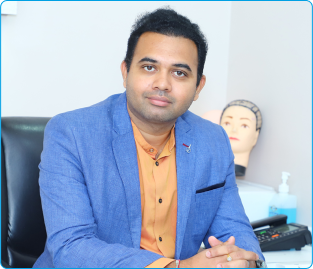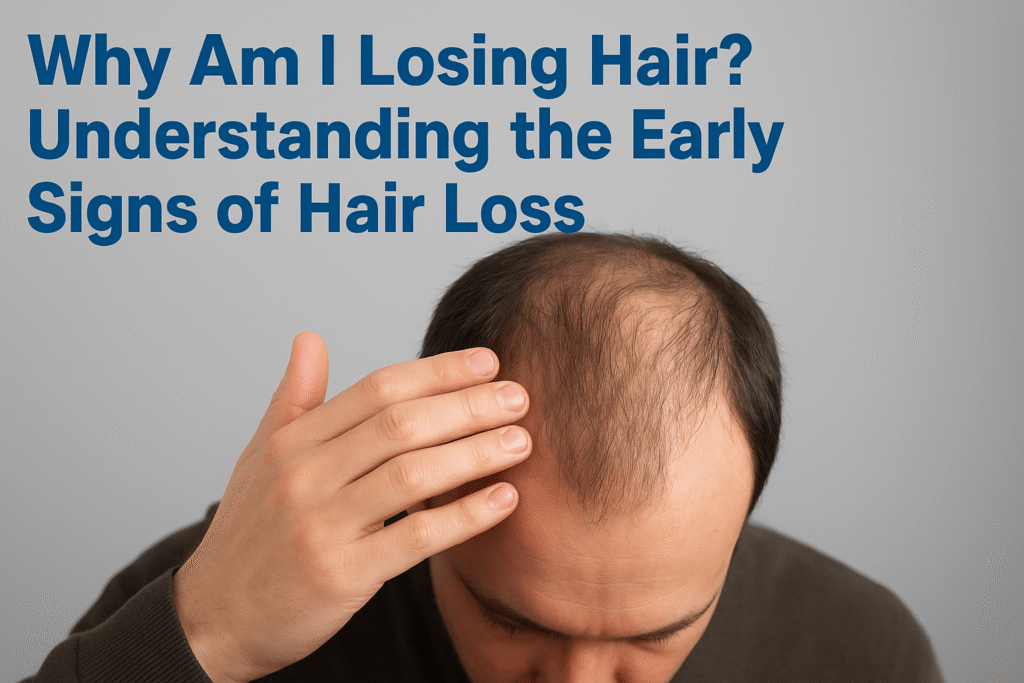Hair loss isn’t just about appearance—it affects confidence, self-esteem, and emotional well-being. As a dermatologist and trichologist with over two decades of experience, I’ve seen firsthand how distressing it can be for patients to watch their hair thin over time.
Introduction: A Game-Changer for Hair Regrowth
Many patients come to me after trying countless oils, shampoos, and supplements—only to see minimal results. The good news? Laser hair therapy offers a proven, non-invasive solution that can revive weak follicles, stimulate new hair growth, and slow down hair thinning.
Key Takeaways:
✔️ Stimulates dormant hair follicles, encouraging natural hair regrowth
✔️ Boosts blood circulation to nourish the scalp and strengthen existing hair
✔️ Non-invasive & pain-free—no needles, surgery, or medications required
✔️ Works for both men & women struggling with hair thinning or early-stage hair loss
✔️ Clinically proven to increase hair density and reduce shedding over time
Let’s dive into how laser therapy works, who it’s best for, and how you can incorporate it into your hair restoration journey.
Table of Contents
- What Is Laser Hair Therapy?
- How Does Laser Hair Therapy Work?
- The Science Behind Laser Hair Growth
- Who Can Benefit from Laser Hair Therapy?
- Types of Laser Hair Therapy Devices
- What to Expect During Treatment
- How Long Does It Take to See Results?
- Combining Laser Therapy with Other Hair Loss Treatments
- Potential Side Effects and Safety Considerations
- Conclusion
- Frequently Asked Questions
1. What Is Laser Hair Therapy?

Laser Hair Therapy: A Game-Changer for Hair Regrowth
If you’re struggling with hair thinning or hair loss, you’re not alone. Many people spend years searching for effective solutions, trying everything from home remedies to expensive treatments—with little success. But what if there was a scientifically backed, painless, and non-invasive way to revive your hair follicles and encourage natural regrowth?
That’s where laser hair therapy comes in. Also known as low-level laser therapy (LLLT), red light therapy, or photobiomodulation, this innovative approach harnesses low-intensity laser or LED light to stimulate weakened hair follicles, encouraging them to grow stronger, thicker, and healthier.
Is There Scientific Proof That Laser Therapy Works?
Absolutely! A 2018 clinical review examined 11 studies on LLLT for hair loss, and 10 of them showed significant hair regrowth. This confirms that laser therapy is a safe, effective alternative for treating androgenic alopecia (pattern baldness) in both men and women.
Different Types of Laser Devices for Hair Loss
The beauty of laser therapy is that you have multiple options:
🔹 Laser Caps & Helmets – Hands-free and convenient, these are worn like regular caps and provide full scalp coverage.
🔹 Laser Combs & Brushes – These require manual movement across the scalp but allow for targeted treatment.
🔹 In-Clinic Laser Therapy – Dermatologists use high-powered medical-grade lasers for faster, more intensive results.
Final Thoughts: Should You Try Laser Hair Therapy?
If you’re looking for a non-surgical, painless, and scientifically supported way to fight hair loss, laser therapy is worth considering. It’s an excellent option for those in the early stages of hair thinning and can be combined with other treatments like minoxidil, PRP therapy, or hair supplements for even better results.
The sooner you start, the better the outcome. So why wait? Explore your options and take the first step toward healthier, thicker hair today!
2. How Does Laser Hair Therapy Work?
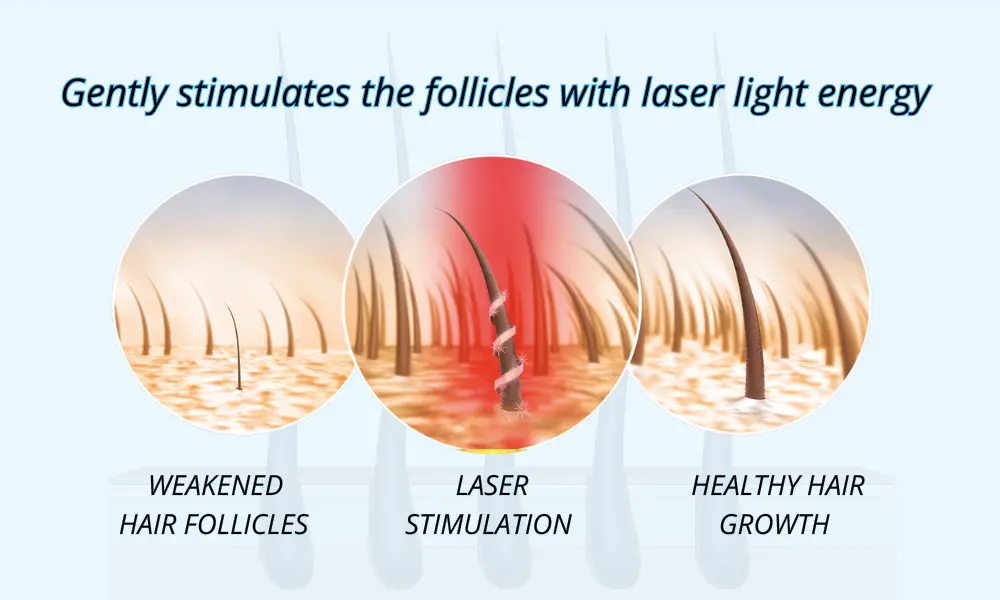
Think of your hair follicles like small factories—when they’re active, they produce hair; when they’re dormant, hair stops growing, leading to thinning and bald spots. Laser therapy “wakes up” these dormant follicles, kickstarting a process that boosts their function and promotes new hair growth.
Here’s what happens when low-level laser light is applied to the scalp:
✔️ Activates Stem Cells – The light stimulates the stem cells responsible for hair production, helping restore weakened follicles.
✔️ Boosts Blood Circulation – Laser energy increases blood flow to the scalp, delivering oxygen and nutrients essential for hair growth.
✔️ Enhances Cellular Activity – It increases specific enzymes that improve follicle function, allowing hair to grow thicker and stronger.
✔️ Encourages Hair Growth Cycle – The laser light shifts hair follicles from their dormant (resting) phase to the active (growth) phase, reducing shedding and promoting regrowth.
3. The Science Behind Laser Hair Growth
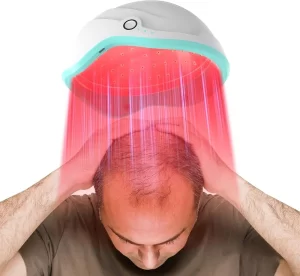
The Science Behind Low-Level Laser Therapy (LLLT) for Hair Regrowth
Hair loss can be distressing, but thanks to advancements in dermatology and hair restoration, low-level laser therapy (LLLT) has emerged as a safe, non-invasive, and effective treatment. Whether you’re experiencing thinning hair, receding hairlines, or androgenic alopecia, LLLT offers a clinically proven way to stimulate dormant hair follicles and promote natural regrowth.
But how does it work? Let’s dive into the science behind LLLT, breaking it down in simple terms so you can understand how light energy can help restore your hair.
How Does Low-Level Laser Therapy Stimulate Hair Growth?
LLLT works by delivering low-power red and infrared light to the scalp, stimulating cellular activity and boosting blood circulation. This nourishes hair follicles, helping them shift from the resting (telogen) phase to the growth (anagen) phase.
The Key Biological Processes Behind LLLT:
✔️ Activates Hair Follicle Stem Cells – The laser light directly stimulates stem cells in the bulge region of the follicle, kickstarting the growth cycle and extending the anagen phase.
✔️ Boosts ATP Production (Cellular Energy) – LLLT stimulates mitochondria, the powerhouse of cells, increasing adenosine triphosphate (ATP) production. This energy boost helps hair follicles grow thicker and stronger strands.
✔️ Enhances Mitochondrial Function – Red light therapy targets cytochrome c oxidase (COX) in the mitochondria, triggering a cascade of cellular reactions that lead to hair regrowth.
✔️ Improves Blood Circulation & Oxygenation – The treatment increases nitric oxide levels, widening blood vessels and allowing more oxygen and nutrients to reach hair follicles.
✔️ Reduces Inflammation & Regulates Immune Response – LLLT modulates inflammation, creating a healthier scalp environment that supports continuous hair regrowth.
Scientific Evidence: Does LLLT Really Work?
Yes! Multiple studies confirm that LLLT can effectively stimulate hair regrowth in individuals with androgenic alopecia (pattern baldness).
📌 A 2018 Review found that LLLT led to significant hair growth improvements in 10 out of 11 clinical trials, proving it to be a reliable treatment for hair loss.
📌 Research also suggests that an 830-nm wavelength results in the highest stimulation of hair regrowth, making it an ideal range for LLLT devices.
📌 FDA-Approved Since 2007 – LLLT has been deemed safe and effective by the U.S. Food and Drug Administration for treating hereditary hair loss in both men and women.
What Makes LLLT a Game-Changer for Hair Loss?
Unlike traditional hair loss treatments, LLLT offers several unique benefits:
🔹 Non-Invasive & Painless – No surgery, no needles, and no discomfort.
🔹 Drug-Free & No Major Side Effects – Unlike medications like minoxidil or finasteride, LLLT doesn’t interfere with hormones.
🔹 Works for Both Men & Women – Suitable for anyone experiencing early to moderate hair thinning.
🔹 Can Be Used with Other Treatments – Pairs well with PRP therapy, topical treatments, and hair growth supplements.
Final Thoughts: Should You Try Laser Hair Therapy?
If you’re looking for a safe, scientifically backed treatment to combat hair thinning, low-level laser therapy is a promising solution. It’s a fantastic option for those in the early stages of hair loss, and when used consistently, it can help restore thicker, healthier hair over time.
🔗 Book a Consultation Today to find out if LLLT is right for you!
4. Who Can Benefit from Laser Hair Therapy?

Who Can Benefit from Laser Hair Therapy? A Guide to Ideal Candidates
Hair loss is a frustrating experience, but thanks to advancements in laser hair therapy, many people can now stimulate hair growth naturally without surgery or medications. However, not everyone is an ideal candidate for this treatment.
If you’re wondering whether low-level laser therapy (LLLT) is the right solution for you, let’s break down who can benefit the most—and who might need to explore other options.
Who Is Laser Hair Therapy Best For?
Laser hair therapy works by stimulating existing hair follicles, making it most effective for those who still have some active follicles. Here’s who can benefit the most:
1. Individuals with Mild to Moderate Hair Thinning
If you’re noticing gradual hair thinning, LLLT can help slow down the process and even encourage new hair growth. It’s particularly effective when treatment starts early, before hair follicles become completely inactive.
💡 Best for: Men and women in the early stages of hair loss who want to maintain and thicken their existing hair.
2. People with Androgenetic Alopecia (Pattern Baldness)
Male and female pattern baldness (androgenetic alopecia) is the most common cause of hair loss, and studies have shown that laser therapy can help slow or even reverse it when started in time.
💡 Best for: Those with visible thinning but still have some hair follicles present.
3. Patients Looking for a Non-Surgical Alternative
Not everyone wants to undergo hair transplant surgery or take medications like finasteride or minoxidil. Laser therapy offers a pain-free, drug-free, and non-invasive solution that requires no downtime.
💡 Best for: Individuals looking for a low-maintenance, side-effect-free hair restoration option.
4. Postpartum Mothers Dealing with Hair Loss
Hormonal changes after pregnancy can cause temporary hair loss, known as postpartum shedding. Since LLLT improves blood circulation and follicle health, it can speed up the natural regrowth process.
💡 Best for: New mothers experiencing temporary, hormone-related hair loss.
5. Individuals Recovering from Stress-Related Hair Shedding
Excessive stress, illness, or sudden weight loss can cause a condition called telogen effluvium, leading to noticeable hair shedding. Laser therapy can support recovery by revitalizing the scalp and strengthening hair follicles.
💡 Best for: People experiencing temporary hair loss due to stress or illness.
Who Might Not Be a Good Candidate for Laser Hair Therapy?
While LLLT is effective for many, it’s not a miracle cure for all types of hair loss. Here are some cases where laser therapy may not be the best option:
1. Individuals with Severe Baldness or Completely Inactive Follicles
Laser therapy cannot regrow hair in areas where follicles are permanently dead. If hair loss has progressed to the point where the scalp is completely bald, other treatments like hair transplants may be more suitable.
🚫 Not ideal for: Those with long-term baldness or completely inactive follicles.
2. Patients with Scarring Alopecia or Severe Scalp Conditions
Certain medical conditions, such as scarring alopecia or severe psoriasis, cause permanent follicle damage, making LLLT less effective.
🚫 Not ideal for: Those with scalp conditions that cause irreversible follicle destruction.
3. People Expecting Instant or Permanent Results
Laser hair therapy takes time—typically 3 to 6 months of consistent use before visible results appear. While it can improve hair density, it does not permanently stop hair loss, and ongoing maintenance is often required.
🚫 Not ideal for: Individuals looking for immediate or permanent regrowth without maintenance.
Final Thoughts: Is Laser Hair Therapy Right for You?
If you’re in the early to moderate stages of hair thinning, struggling with pattern baldness, or looking for a non-invasive solution, laser hair therapy could be the perfect option for you. However, if you’re dealing with advanced baldness or scarring conditions, it may be time to explore other hair restoration treatments.
Still unsure? The best way to find out if laser hair therapy is right for you is to consult a hair specialist for a personalized assessment.
🔗 Book a Consultation Today and take the first step toward healthier, fuller hair!
5. Types of Laser Hair Therapy Devices
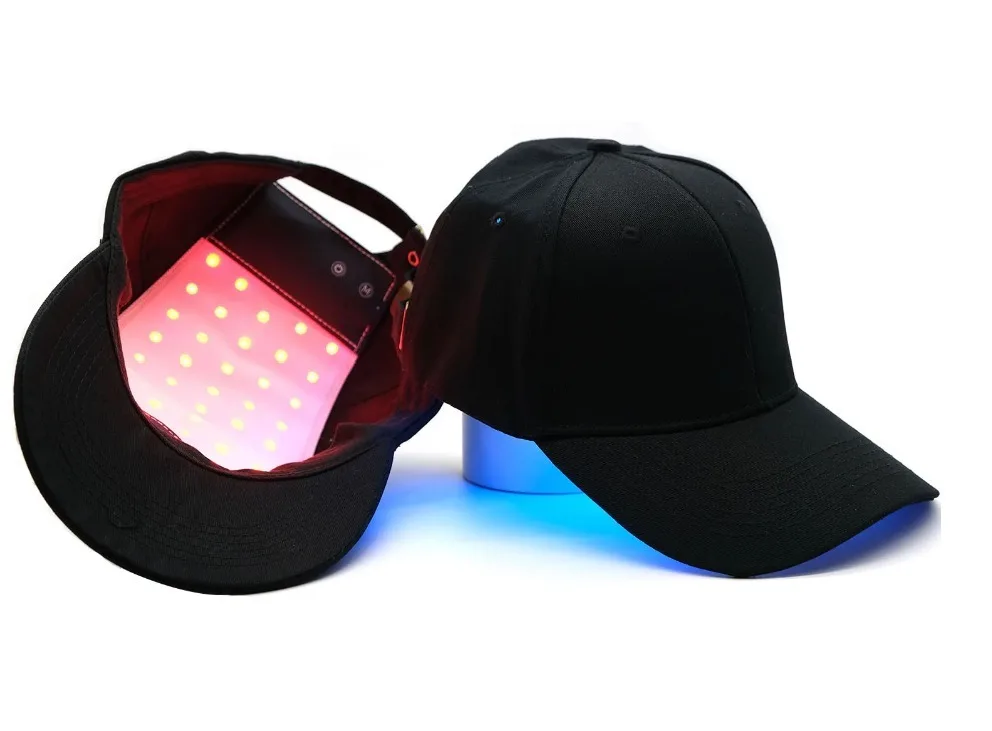
Choosing the Right Laser Hair Therapy Device: A Complete Guide
If you’re considering laser hair therapy for hair regrowth, you might be wondering: Which device is best for me? With so many options available—ranging from in-clinic laser treatments to at-home laser caps, combs, and helmets—it’s important to understand how each one works and which suits your needs best.
Let’s explore the different types of low-level laser therapy (LLLT) devices and how they can help you combat hair thinning and hair loss effectively.
Types of Laser Hair Therapy Devices
Laser hair therapy devices are available in two main categories: professional in-clinic treatments and at-home devices designed for personal use.
1. In-Clinic Laser Treatments
For those looking for medical-grade, high-powered laser therapy, in-clinic laser treatments provide intensive and closely monitored sessions.
✔️ Performed by dermatologists or hair specialists
✔️ Uses stronger, medical-grade lasers
✔️ Sessions last 20-30 minutes
✔️ Recommended 2-3 times per week for best results
These treatments are ideal for individuals who want professional supervision or have advanced hair thinning that requires stronger stimulation.
🔗 Learn More About In-Clinic Laser Hair Therapy
2. At-Home Laser Devices
For those who prefer convenience, FDA-approved at-home laser devices allow you to treat hair loss at home with minimal effort. These devices typically require 15-30 minutes per session and can be used several times a week for noticeable results.
There are two main types of at-home laser therapy devices:
🔹 Laser Caps & Helmets
These provide full scalp coverage, ensuring even distribution of laser energy across the head. Some advanced models even pause automatically if they shift out of position.
✔️ Hands-free and easy to use
✔️ Covers the entire scalp
✔️ Ideal for widespread hair thinning
Popular Laser Caps & Helmets:
- Capillus272 Pro – Uses 272 red, 650nm laser diodes for powerful follicle stimulation.
- iGrow-II Hair Growth System – Combines laser diodes (LDs) and LEDs for a multi-technology approach.
- iRestore – Uses a mix of laser diodes and LEDs for enhanced coverage.
🔗 Shop FDA-Approved Laser Caps Here
🔹 Laser Combs & Bands
Unlike caps and helmets, laser combs and bands require manual movement across the scalp. These devices focus the laser light on targeted areas, making them great for localized thinning.
✔️ More affordable than caps or helmets
✔️ Provides direct laser stimulation to specific areas
✔️ Requires manual use, so treatment time may vary
Popular Laser Combs & Bands:
- HairMax LaserComb – Delivers direct laser light through comb teeth.
- LaserBand 82 ComfortFlex – Offers full scalp coverage with quick 90-second sessions.
🔗 Browse Top-Rated Laser Combs & Bands
Do Laser Devices Use LEDs or Laser Diodes?
Different laser therapy devices use either laser diodes, LEDs, or a combination of both:
✔️ Laser Diodes (LDs): Provide focused, high-intensity light that penetrates deep into hair follicles.
✔️ LEDs: Offer wider coverage but less penetration compared to laser diodes.
✔️ Combination Devices: Use both technologies to balance depth and coverage.
A systematic review found a statistically significant difference in effectiveness between pure laser light and LED-based sources (p=0.043), suggesting that laser diodes may be more effective for hair regrowth.
Which Laser Hair Therapy Device Should You Choose?
Your choice of device depends on your hair loss severity, lifestyle, and budget:
✔️ For severe hair thinning: In-clinic treatments or high-powered laser helmets/caps are best.
✔️ For mild to moderate thinning: Laser combs or bands provide targeted stimulation.
✔️ For convenience: Hands-free laser caps and helmets allow easy use while multitasking.
✔️ For affordability: Laser combs are a budget-friendly option that still delivers results.
🔗 Compare the Best Laser Hair Therapy Devices Here
Final Thoughts: Is Laser Hair Therapy Right for You?
If you’re experiencing hair thinning or early-stage hair loss, investing in a high-quality laser hair therapy device can be a game-changer. Whether you choose an in-clinic treatment or an at-home laser device, consistent use is key to seeing noticeable hair regrowth and improved scalp health.
🔗 Book a Consultation to determine the best laser therapy option for your hair loss and start your journey to thicker, healthier hair today!
6. What to Expect During Treatment
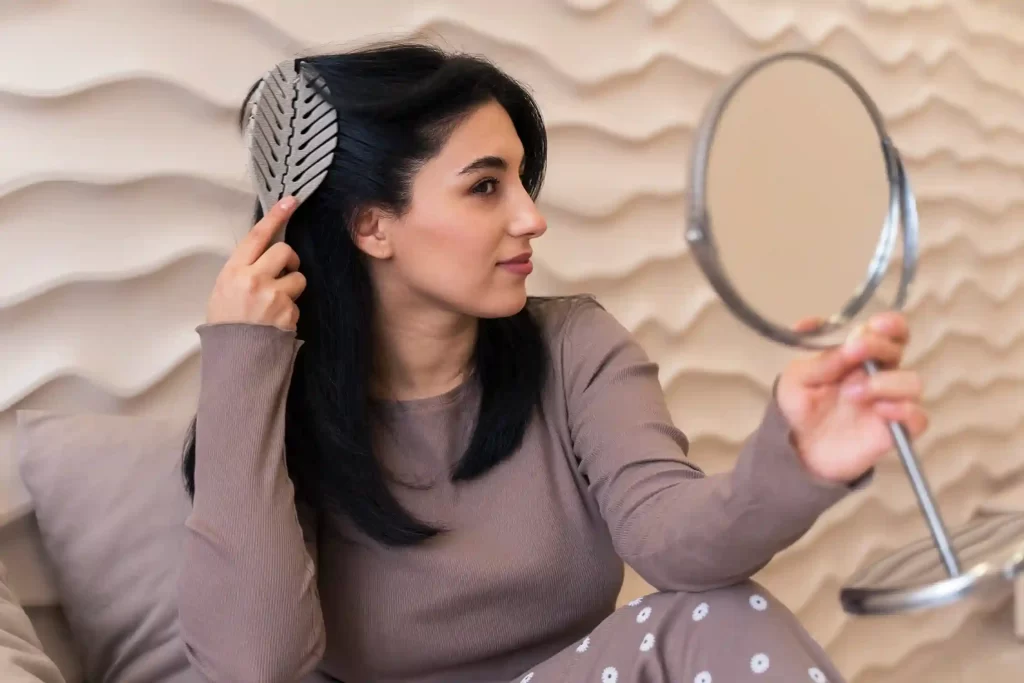
What to Expect During Laser Hair Therapy: A Step-by-Step Guide
If you’re considering laser hair therapy to combat hair thinning or hair loss, you might be wondering what the experience is like. The good news? It’s painless, non-invasive, and requires no downtime—making it one of the most convenient hair restoration treatments available.
Here’s exactly what you can expect during low-level laser therapy (LLLT) sessions, along with tips to maximize your results.
1. A Painless and Relaxing Experience
One of the biggest advantages of laser hair therapy is that it’s completely painless.
✔️ No needles, no discomfort, and no recovery time
✔️ Many patients describe it as a gentle warming sensation on the scalp
✔️ Sessions are calm and relaxing, allowing you to unwind while the lasers work
Some people even use their at-home laser caps or helmets while reading, watching TV, or working on their laptop!
2. No Downtime—Resume Your Day Immediately
Unlike surgical hair restoration procedures, laser hair therapy doesn’t require any recovery time.
✔️ No redness, irritation, or discomfort after sessions
✔️ You can immediately return to work, exercise, or social activities
✔️ Safe for all skin types with zero major side effects
This makes LLLT an ideal choice for busy professionals, parents, and anyone looking for a hassle-free treatment.
3. A Treatment Schedule That Requires Consistency
For best results, consistency is key.
📅 Typical Treatment Plan:
🔹 2-3 sessions per week using an in-clinic device or at-home laser cap
🔹 Each session lasts 15-30 minutes depending on the device
🔹 Commit to at least 3-6 months of regular use for noticeable improvements
Like any hair regrowth treatment, patience and consistency are crucial—but the payoff is worth it!
4. Gradual Improvement Over Time
Hair restoration is a process, and results don’t happen overnight. Here’s what you can expect:
✔️ First Few Weeks: Reduction in hair shedding as follicles begin responding to laser therapy.
✔️ Month 3-4: New baby hairs start appearing, and existing strands feel thicker.
✔️ Month 5-6: Fuller, healthier hair becomes noticeable, with less thinning and more density.
Results vary depending on the severity of hair loss and treatment consistency, but most users see significant improvements within six months.
5. Follow-Up Sessions to Track Progress
To ensure optimal results, it’s recommended to have follow-up check-ins with a hair specialist.
✔️ A dermatologist or hair expert can evaluate progress and make adjustments if needed
✔️ Some patients may benefit from combining LLLT with PRP therapy, minoxidil, or hair growth supplements
✔️ Regular follow-ups help fine-tune the treatment and maximize hair regrowth
Final Thoughts: Is Laser Hair Therapy Right for You?
If you’re looking for a painless, non-invasive, and scientifically proven way to restore your hair, laser hair therapy is worth considering. By staying consistent with 2-3 sessions per week, you can expect gradual, natural-looking hair regrowth within a few months.
💡 Want to know if you’re a good candidate? Book a Consultation today and take the first step toward thicker, healthier hair!
7. How Long Does It Take to See Results?

I know how frustrating it can be to start a hair loss treatment and wonder, “When will I actually see results?” With laser hair therapy, patience and consistency are key. While everyone’s hair responds differently, here’s a general timeline of what you can expect:
📅 Month 1-2: You’ll likely notice less hair shedding—this is a great sign that the treatment is starting to work! Your scalp may also feel healthier, with improved circulation feeding your hair follicles.
📅 Month 3-4: This is when things get exciting! New baby hairs begin to appear, and your existing strands may start to feel thicker and stronger.
📅 Month 5-6: By this stage, you should see a noticeable difference in hair density and fullness. Your hair looks and feels healthier, with more volume and less visible thinning.
🔑 The most important thing? Stay consistent! Skipping sessions or stopping too soon can slow progress, so stick with your treatment plan for the best long-term results.
8. Combining Laser Therapy with Other Hair Loss Treatments

Boosting Your Results: What Works Best with Laser Hair Therapy?
While laser hair therapy is effective on its own, combining it with other treatments can supercharge your results. Think of it like a well-rounded fitness routine—just as diet and exercise work together for better health, the right hair treatments can work synergistically for thicker, stronger hair.
Here are some great additions to your laser therapy routine:
✔️ Minoxidil (Rogaine): This popular topical treatment stimulates hair follicles and helps extend the growth phase of your hair cycle, making it a perfect partner for laser therapy.
✔️ PRP (Platelet-Rich Plasma) Therapy: Using your own growth factors, PRP therapy accelerates cellular repair and regeneration, enhancing the effects of laser treatment.
✔️ Nutritious Diet & Hair Supplements: Healthy hair starts from within! Adding biotin, iron, vitamin D, and omega-3s to your routine can strengthen hair follicles and improve overall scalp health.
By combining these treatments, you maximize your hair regrowth potential and give your follicles everything they need to thrive!
9. Potential Side Effects and Safety Considerations
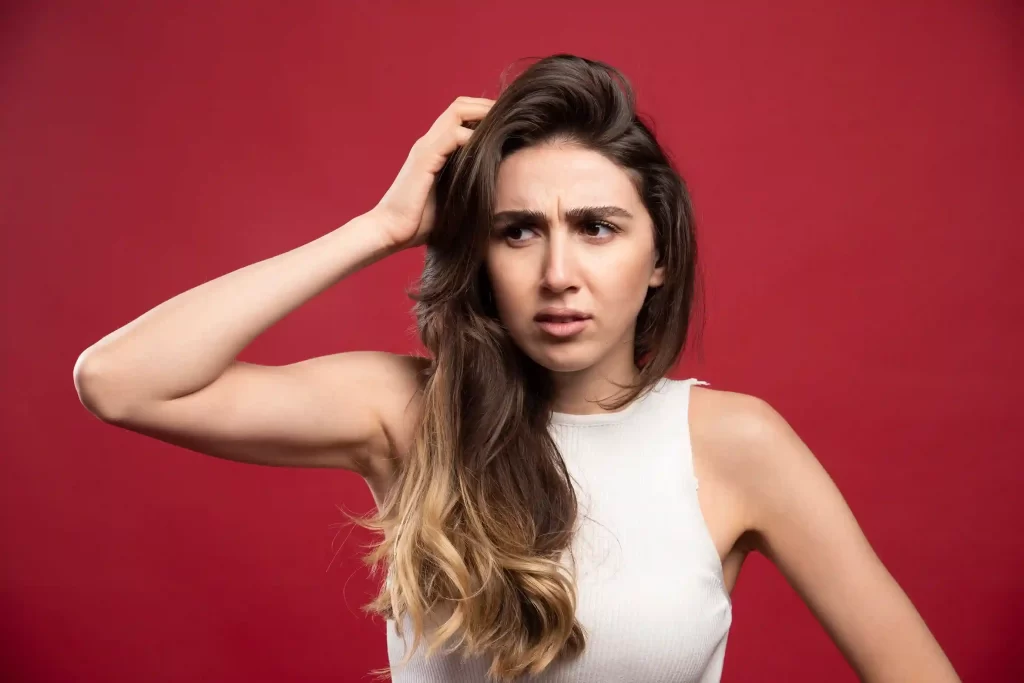
Are There Any Side Effects? What You Need to Know
One of the best things about laser hair therapy (LLLT) is that it’s safe, painless, and FDA-approved—which means you can use it with confidence. Unlike medications that may cause unwanted side effects, LLLT is non-invasive and well-tolerated by most people.
Here’s what you need to know:
✅ No major side effects – Most people experience zero discomfort during or after treatment. Some may feel a slight warming sensation, but that’s just increased blood flow doing its job!
✅ Works for all hair types & scalp conditions – Whether your hair is straight, curly, thick, or fine, LLLT can help strengthen follicles and encourage natural regrowth.
🚫 A few exceptions – If you have scalp psoriasis, severe dermatitis, or any active scalp infections, it’s best to consult a dermatologist first before starting treatment.
Overall, LLLT is one of the safest hair loss treatments available—a stress-free way to support thicker, healthier hair without any major risks!
10. Conclusion
If you’re experiencing thinning hair or early-stage hair loss, laser hair therapy (LLLT) could be a safe and effective solution. This non-invasive, FDA-approved treatment stimulates hair follicles, increases blood circulation, and encourages natural regrowth. It’s completely painless, drug-free, and suitable for both men and women. Most people notice less shedding within 1-2 months and visible hair growth by 3-6 months with consistent use. LLLT works best for those with active hair follicles—it won’t revive completely dead follicles. It can also be combined with Minoxidil, PRP therapy, or hair supplements for enhanced results. Since there’s no downtime, you can easily incorporate it into your routine. If you’re unsure whether it’s right for you, a personalized hair assessment can help. Take a free online hair test today to receive a customized hair care plan from a dermatologist.
🔗 Start Your Free Hair Test Now and take the first step toward healthier, fuller hair!
📲 Take Your Online Hair Test Now
Frequently Asked Questions (FAQs)
- What is laser hair therapy, and how does it work?
Laser hair therapy, also known as low-level laser therapy (LLLT), uses red or infrared light to stimulate hair follicles, improve blood circulation, and promote hair regrowth without surgery or medications. - Who is laser hair therapy best suited for?
It is most effective for men and women with mild to moderate hair thinning or early-stage hair loss. It works best when hair follicles are still active. - Can laser hair therapy completely reverse baldness?
No, LLLT cannot regrow hair in fully bald areas where hair follicles are inactive. It works by strengthening existing follicles and promoting growth in thinning areas. - How long does it take to see results?
Results vary, but most users notice less shedding within 1-2 months and visible hair regrowth within 3-6 months of consistent use. - Are there any side effects of laser hair therapy?
No major side effects—it is a non-invasive, FDA-approved treatment. Some users may experience a slight warming sensation due to increased blood circulation. - What are the different types of laser hair therapy devices?
The most common options include:- Laser caps & helmets (hands-free, full scalp coverage)
- Laser combs & brushes (manual application for targeted treatment)
- In-clinic laser therapy (medical-grade lasers for intensive results)
- Can laser therapy be combined with other hair loss treatments?
Yes! It works well with Minoxidil (Rogaine), PRP therapy, and hair growth supplements to enhance results. - How often should I use laser hair therapy?
- 2-3 times per week is recommended for best results.
- Sessions typically last 15-30 minutes, depending on the device.
- Is laser hair therapy painful?
No, it is completely painless and requires no downtime. You can go about your day immediately after treatment. - How much does laser hair therapy cost?
- In-clinic sessions: Approximately ₹4,344 to ₹17,374 per session.
- At-home laser devices: Approximately ₹34,748 to ₹260,610 (one-time investment)..






